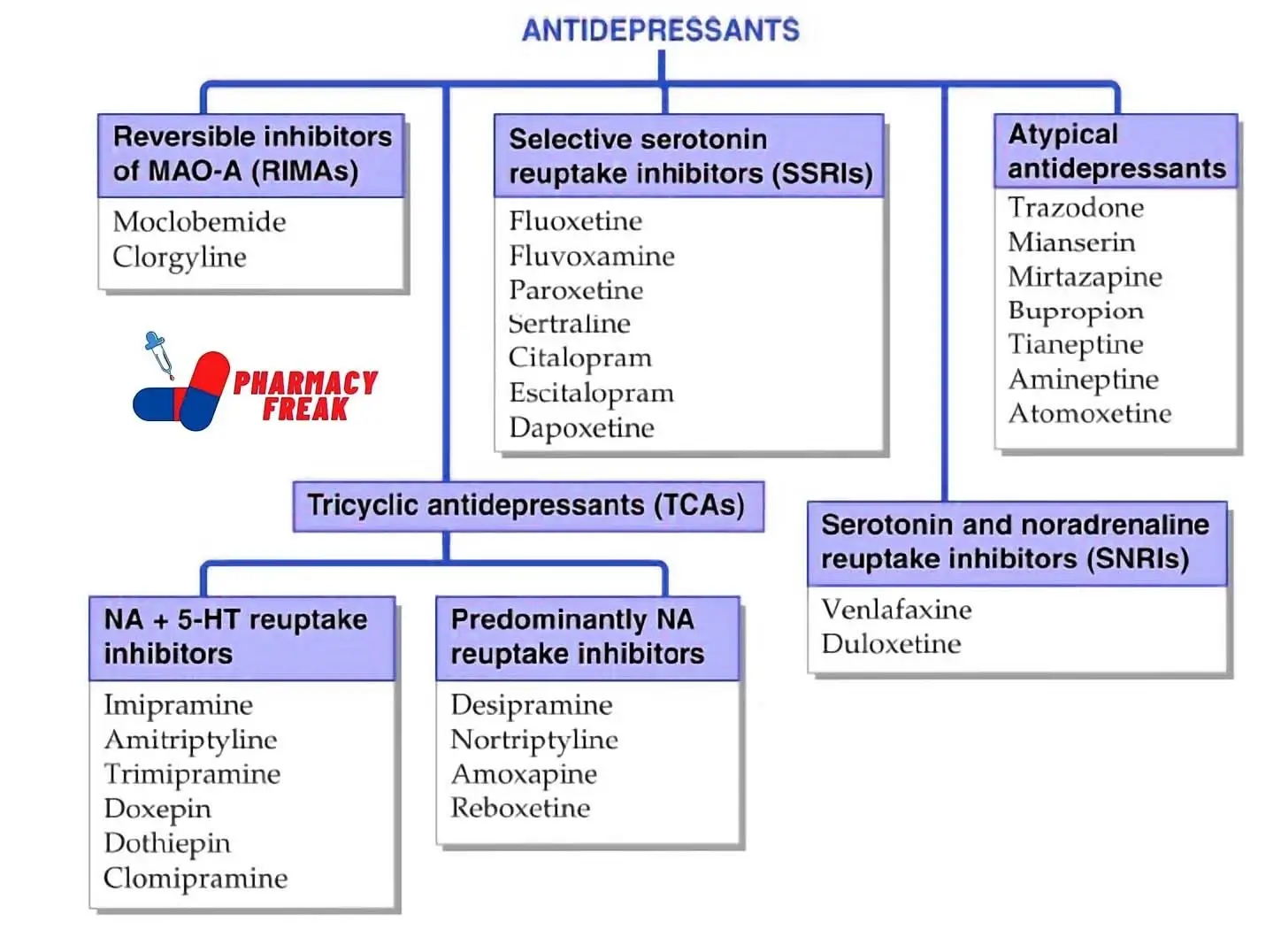Table of Contents
Antidepressants are typically categorized into several classes based on their mode of action. Each class targets specific neurotransmitters or receptor systems in the brain. Here are the primary classes of antidepressants:
- Reversible inhibitors of MAO-A (RIMAs)– Moclobemide, Clorgyline
- Tricyclic antidepressants (TCAs)-
- NA+ 5-HT reuptake inhibitors– Imipramine, Amitriptyline, Trimipramine, Doxepin, Dothiepin, Clomipramine
- Predominantly NA re-uptake inhibitors– Nortriptyline Amoxapine Desipramine Reboxetine
- Selective serotonin re-uptake inhibitors (SSRIs)- Fluoxetine, Fluvoxamine, Paroxetine, Sertraline, Citalopram, Escitalopram, Dapoxetine
- Serotonin and noradrenaline re-uptake inhibitors (SNRIs)– Venlafaxine, Duloxetine
- Atypical antidepressants– Trazodone, Mianserin, Mirtazapine, Bupropion, Tianeptine, Amineptine, Atomoxetine
Selective Serotonin Reuptake Inhibitors (SSRIs)
SSRIs are among the most commonly prescribed antidepressants. They work by increasing the levels of serotonin, a neurotransmitter associated with mood regulation, in the brain. SSRIs include well-known medications like:
- Fluoxetine (Prozac)
- Sertraline (Zoloft)
- Paroxetine (Paxil)
- Escitalopram (Lexapro)
- Citalopram (Celexa)
SSRIs are often the first-line treatment for depression due to their efficacy and relatively mild side effect profile.
Serotonin and Norepinephrine Reuptake Inhibitors (SNRIs)
SNRIs, as the name suggests, affect both serotonin and norepinephrine levels. These neurotransmitters play key roles in mood regulation. Common SNRIs include:
- Venlafaxine (Effexor)
- Duloxetine (Cymbalta)
- Desvenlafaxine (Pristiq)
SNRIs may be prescribed when SSRIs are ineffective or if a patient also experiences symptoms like chronic pain.
Tricyclic Antidepressants (TCAs)
TCAs are an older class of antidepressants. They work by inhibiting the reuptake of serotonin and norepinephrine, increasing their levels in the brain. TCAs are effective but often come with more side effects compared to newer classes. Examples include:
- Amitriptyline
- Imipramine
- Doxepin
Monoamine Oxidase Inhibitors (MAOIs)
MAOIs are among the oldest antidepressants and are usually prescribed when other treatments fail. They work by inhibiting the enzyme monoamine oxidase, which breaks down neurotransmitters like serotonin, norepinephrine, and dopamine. Due to potentially severe interactions with certain foods and medications, MAOIs are less commonly used today. Examples include:
- Phenelzine (Nardil)
- Tranylcypromine (Parnate)
Atypical Antidepressants
This class includes antidepressants that don’t fit neatly into the above categories. They have diverse mechanisms of action and are often used when other medications are ineffective or cause intolerable side effects. Some atypical antidepressants include:
- Bupropion (Wellbutrin): Increases norepinephrine and dopamine levels.
- Mirtazapine (Remeron): Enhances serotonin and norepinephrine transmission.
- Trazodone: Primarily used as a sleep aid, it can also treat depression.
Other Novel Antidepressants
Continual research in the field of psychiatry has led to the development of newer antidepressants with unique mechanisms. One such example is Esketamine (Spravato), a nasal spray that targets the glutamate system and is used in treatment-resistant depression.
Combination Therapies
In some cases, healthcare providers may prescribe a combination of different classes of antidepressants or combine an antidepressant with psychotherapy for enhanced effectiveness.
Reference
- Classification of Progestins- KD Tripathi
- National Library of Medicine- Antidepressants
Related Links

I am a Registered Pharmacist under the Pharmacy Act, 1948, and the founder of PharmacyFreak.com. I hold a Bachelor of Pharmacy degree from Rungta College of Pharmaceutical Science and Research. With a strong academic foundation and practical knowledge, I am committed to providing accurate, easy-to-understand content to support pharmacy students and professionals. My aim is to make complex pharmaceutical concepts accessible and useful for real-world application.
Mail- Sachin@pharmacyfreak.com
